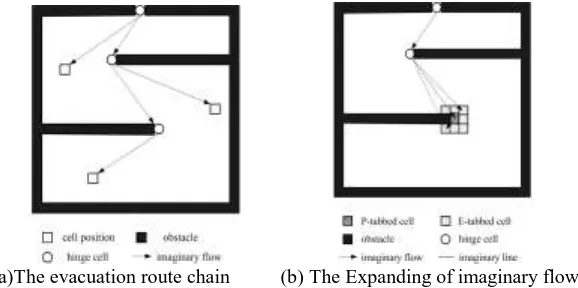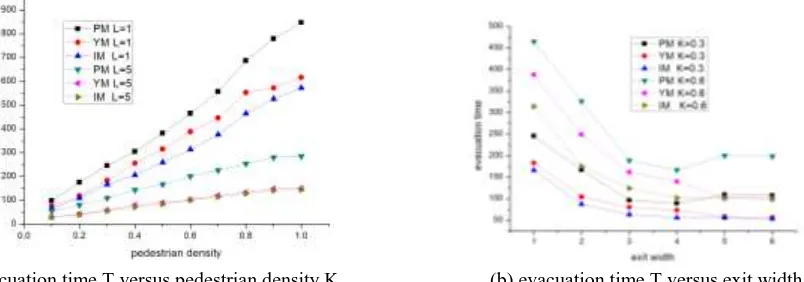2017 2nd International Conference on Computational Modeling, Simulation and Applied Mathematics (CMSAM 2017) ISBN: 978-1-60595-499-8
Pedestrian Evacuation with Obstacles Based
on Dynamic Parameters Model
Nuo ZHU
*China Academy of Civil Aviation Science and Technology, Beijing, 100028, China
*Corresponding author
Keywords: Cellular automata, Pedestrian evacuation, Evacuation time.
Abstract: Dynamic Parameters Model with obstacles is presented in this paper, pedestrian moving rules are established according to two-dimensional cellular automaton Moore neighborhood. The dynamic parameters: Direction-parameter, Empty-parameter and Cognition-parameter are formulated to tactically simplify the decision-making process of pedestrians, which can decide pedestrians’ choice of action. The improved Dijkstra metric is adopted to compute the values of static floor field for evacuation system with obstacles based on the Euclidean distance. In order to show the advanced nature of the model, comparative analysis, experiments and simulation are presented in this paper.
Introduction
Pedestrian flow simulation is a topic of pedestrian flow studies in the field of traffic and granular flow. Cellular automata (CA) model has been adopted widely and well received as an effective tool in the study of this sphere [1], a real-coded cellular automata [2] is proposed to simulate the pedestrian dynamics in evacuation. The evacuation process with obstacles is simulated using lattice gas model. A floor field model [3] was modified to simulate pedestrian evacuation flow with internal obstacles and multi-exit. Dynamic Parameters Model [4-9] has been used to simulate and study the pedestrian flow. An improved dynamic parameter model [10] is presented, which reflects the judgment of pedestrians on surrounding conditions and the action of choosing or decision (consider the impact of pedestrian density near exits on the evacuation process). However, the model [10] has not taken into account the impact of obstacles on pedestrian evacuation, the obstacles (e.g. seat, table) will have an impact on pedestrians’ evacuation routes and evacuation time, which is essential for pedestrian safety. In this paper, the DPM with obstacles based on model [10] is presented to simulate the decision-making process of pedestrians, considering the effects of obstacles and jam around exits.
Model Description
The model is defined on a discrete (𝑊+2) *(𝑊+2) cell grid in the two-dimensional system, where the movement area is marked out into 𝑊*𝑊 same cells, pedestrian cannot pass through obstacles and must leave evacuation system through exits. After leaving system, pedestrian will not reenter the room. In each discrete time step, pedestrians choose to wait or move to the next possible position in the movement field (see Fig. 1(b)). A 3*3 matrix of transition payoff (see Fig. 1(c)) is constructed.
. -1 -1
P, P-1 0, P-1 1,
0 -1
P, P0,0 P0,1
1 -1
P, P1,0 P1,1
(a) Simulation system (b)The movement field (c)The matrix of transition payoffs
Direction-parameter: Once the geometry of the room is determined, each cell is assigned a constant value representing its distance to the exit. The smaller distance, the greater attractiveness it has to pedestrians and the stronger desire of pedestrians to move toward the cell. However, pedestrian evacuation model assumes pedestrians cannot pass through obstacles, so pedestrians must reach destination detour or avoid obstacles. We propose the improved Dijkstra metric to compute the values of static floor field with obstacles based on the Euclidean distance. We define the cells around obstacles which pedestrians must pass through as hinge cells, the direction will change while imaginary flow via hinge cells. There is an hierarchical relationship between the hinge cells, exits are defined as the first-class hinge cells, imaginary flow following pass through second-class, third-class, …, i th-class hinge cells, the i th-class hinge cells are the parent of the (i+1)th-class hinge cells and the offspring of the (i-1)th-class hinge cells. Every cell has parent hinge cells and all parent hinge cells attributes to exits, the value of static floor field is the sum of straight-line Euclidean distance between parent hinge cells. When the cell is expanded to E-tabbed cell, if there are no obstacles between E-tabbed cell and parent hinge cell of P-tabbed cell, P-tabbed cell and E-tabbed cell have the same parent hinge cells, however, if obstacles exist between E-tabbed cell and parent hinge cell of P-tabbed cell, P-tabbed cell is defined as hinge cell of E-tabbed cell (see Fig. 2(b)).
[image:2.595.155.444.313.457.2]
(a)The evacuation route chain (b) The Expanding of imaginary flow
Figure 2. Pedestrian evacuation route chain and the imaginary flow Expanding from P-Tabbed cell to E-Tabbed cell.
00
2 2
i ij ij
S S
D
j
(1)
Where S00—the shortest distance from the core cell in the movement field to the evacuation exits.
ij
S —
the shortest distance from the cell (i, j) in the movement field to the evacuation exits
Empty-parameter indicates whether the cell is occupied or not. The values of elements of Empty-parameter matrix are given as
max( ), empty cells,
0, the core cell, max( ), occupy cells,
ij
ij
ij
D
E
D
(2)
Where dm-the width of m-th exits; dL-the sum width of exits; in t
p
-the number of pedestrians in
the system at t time step; m t
p
-the number of pedestrians around m-th exits at t time step; t in
S
-the
region of the evacuation system at t time step; t m
S
- evacuation region around m-th exits at t time step.
Rules
(1) In the model, the pedestrian can only move one cell and has nine possible target positions to select in each time step.
(2) Define transition payoff Pij as:
ij ij ij ij
P =D +E + C
(4)
1, ( , , 0)
, in every time step, the pedestrian would choose the cell with the largest
value PM (PM=max (Pij)) in the matrix of transition payoff as his or her target position.
(3) If more than one possible target cells rank the highest in value Pij, only one of them will be chosen as the target position randomly with equal probability.
(4) A conflict occurs when any two or more pedestrians attempt to move to the same target position. In this situation, only one of them will be chosen randomly with equal probability.
(5) When a pedestrian moves into the exit cell, at the next time step the pedestrian will leave the room. After leaving the room, the pedestrian would not reenter the room.
(6) When all pedestrians leave the room and there is no pedestrian in the evacuation room, the simulation procedure is terminated.
Simulation Analysis
[image:3.595.268.457.452.594.2]
(a)hinge cells and imaginary flow (b) the difference between experimental and simulation
Figure 3. The influence of parameter variation.
[image:4.595.100.502.75.216.2]
(a) evacuation time T versus pedestrian density K (b) evacuation time T versus exit width L
Figure 4. The comparative superiority of the improved model.
In order to show the advanced nature of improved model, we compare it with the previous model (Ref.[10]) and Yue’s model (Ref.[8]) in the same conditions. We plot the evacuation time T versus pedestrian density K and exit width L (Fig. 4(a) and (b)) with respect to the previous model (PM), Yue’s model (YM) and improved model (IM), it is clearly seen that improved model and Yue’s model are better than previous model. Moreover, when exit width is small (such as L=1), the evacuation time of Yue’s model and improved model are almost the same while pedestrian density is low (0.1<P<0.3), but the gap gradually revealed while the density increase when exit width is large enough, there is almost no difference between Yue’s model and improved model. This is mainly because Yue’s model defines “congested area”, pedestrian will judge the waiting time and change the evacuation routes or exits according to congestion situation in this area; however, “congested area” is static area while exit width is determined, pedestrians only enter into the area to perceive the congestion situation and waiting time. The improved model introduces Cognition-parameter and Dijkstra metric, can dynamically perceive surrounding environment, and then make a quick choice rather than just in a specific area. When exit width reaches a certain level, “congested area” can cover the entire evacuation space, Yue’s model and improved model are basic equivalent.
Conclusions
In this paper, Dynamic Parameters Model with obstacles is proposed according to two-dimensional cellular automaton Moore neighborhood. The hinge cells and Dijkstra metric are introduced which can reflect the pedestrian judgment on the surrounding conditions and decide the pedestrian’s choice of action. The simulation results of the improved model, Yue’s model and previous model are compared, it is found that improved model has a good advanced nature and simulation results are consistent with the real situation. In our model, we consider the effects of the crowd distribution in evacuation process, it is helpful to evaluate the complex moving behaviors of pedestrians.
Acknowledgements
This paper is financially supported by the National Natural Science Foundation of China (Nos. 11422221 and 11672289).
References
[4] Th. Robin, G. Antonini, M. Bierlaire, J. Cruz, Specification, estimation and validation of a pedestrian walking behavior model, Transp. Res. Part B 43 (2009) 36-56.
[5] H. Yue, H. Hao, X. Chen, C. Shao, Simulation of pedestrian flow on square lattice based on cellular automata model, Physica A 384 (2007) 567-588.
[6] H. Yue, C. Shao, Z. Yao, Pedestrian evacuation flow simulation based on cellular automata, Acta Phys. Sinica 58 (2009) 4523-4530.
[7] H. Yue, C. Shao, X. Chen, H. Hao, Simulation of bi-directional pedestrian flow based on cellular automata model, Acta Phys. Sinica 57 (2008) 6901-6908.
[8] H. Yue, Zhang B Y, Shao C F, Xing Y, Exit selection strategy in pedestrian evacuation simulation with multi-exits, Chin. Phys. B 23(2014) 050512.
[9] Zhang L, Yue H, Li M, Wang S, Mi X Y, Simulation of pedestrian push-force in evacuation with congestion, Acta Phys. Sin.64(2015) 060505 (in Chinese).


